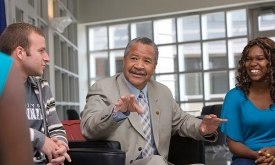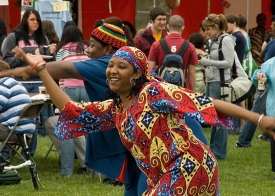University of Cincinnati embraces diversity as a core value; nation takes notice
by Deborah Rieselman
Emotions couldn't get much higher in 1964 for college freshman Mitchel Livingston, who was in Austin, Texas, preparing to compete in one of the country's biggest track and field events, the Texas Relays. Within moments, however, his emotions would plummet when he found an anonymous note on his duffle bag: "If you win this event, you will die."
The only black competitor on his Southern Illinois University team, Livingston (now a vice president at UC) finished in second place. He can't say whether the intimidation hurt his performance, but he certainly admits it scarred his memories.
Unfortunately, the rest of the trip, which included two more meets in Florida, was no better: The whole team was refused admission to a pool hall in Louisiana, and the drive home through Alabama was grueling. "We had to drive through the entire state before we could find a restaurant that would allow us to come in as a team and eat," he recalls.
"I remember all those incidents like they were yesterday. That was my introduction to higher education."
Instead of instilling Livingston with hate, the incidents forged in him a determination to stop such introductions from being commonplace for minorities. In the early 1990s, Livingston created the award-winning Just Community Initiative while vice president of student affairs at New York's University at Albany. In 1994, he joined UC in the same VP position and brought his initiative with him. Its goals, in part, are to "promote justice, embrace freedom, practice civility and celebrate the uniqueness of each individual."
In 2008, he became the University of Cincinnati's first chief diversity officer, a significant step in the university's path to prove its seriousness in embracing diversity as a core value. Livingston's new title is the result of the president's office assembling a task force in 2006 to create an agenda for change, using a broad concept of diversity that includes race, ethnicity, gender, age, disability, socioeconomic status, sexual identity, sexual orientation, religion, and regional or national origin.
In the end, the task force created the CDO position, established a permanent diversity council and rewrote the university's mission statement to reflect its new commitment. Diversity Council members realize that many people mistake diversity for a focus on numbers, demographics and compliance with directives. Yet diversity is more about creating a welcoming environment and affirming the value of all persons, they insist. Furthermore, a wide range of perspectives is vital for functioning in a global economy these days.
"Diversity is much larger than race," says Livingston. "Race still matters, but diversity is the defining characteristic of American higher education.
"You can't have a university without diversity expressed in every way possible -- diversity in curriculum, faculty, students, even architecture. Diversity and excellence are threads of one cloth. One cannot occur without the other."
"This is not just about equality," adds Lou Bilionis, Diversity Council chair and dean of the College of Law. "It's about tapping the diversity of human nature to get stronger, to create a place where more and more talented people will want to come, where the range of perspectives will grow."
The university's definition of diversity will grow as well. "Twenty years from now, there will be common dimensions of diversity and inclusion that we're not seeing clearly today," Bilionis says. "We want to be really mindful of that and be responsive to those as they emerge -- ideally, anticipate them before they emerge."
To keep the campus community aware of its strategy, the Diversity Council and the Just Community Initiative have sponsored or hosted many events, including the UC Diversity Conference in 2009, the annual Worldfest Week and speakers such as Colin Powell, poet Maya Angelou and Holocaust survivor and Nobel Laureate Elie Wiesel. It also awarded grants supporting recruitment and retention.
To measure progress, the council recently completed an audit that showed 500 diversity initiatives across campus. Plus, UC's efforts in the field have attracted national attention.
First, the university was listed in "The Templeton Guide: Colleges that Encourage Character Development" because of its Just Community Initiative. Then in 2008, the Princeton Review ranked UC 19th in the nation for having a diverse student population, based partially upon student interviews. The publication called the campus "a vibrant quilt of culture" and quoted one student as saying, "It could be considered the melting pot college of the Midwest."

 Issue Archive
Issue Archive
